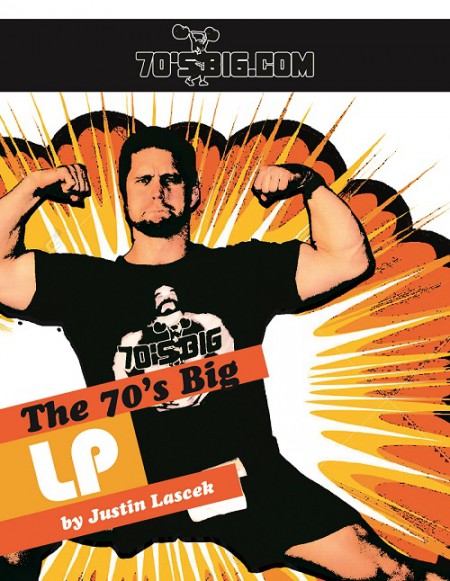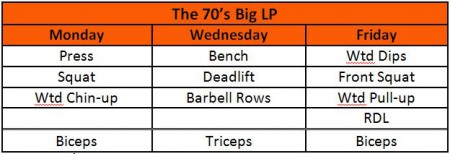 I know what you’re thinking: “What kind of a stupid asshole puts himself on a cover like that?”
I know what you’re thinking: “What kind of a stupid asshole puts himself on a cover like that?”
The answer is an asshole who wants to get you stronger. Jacked. Thick. TIGHT!
When I first started planning this book in 2011, I considered it an arm training program. But as I experimented and wrote, it became clear that it’s a legitimate program…that just so happens to make impressive arms.
The 70’s Big LP is a…
- Linear Strength Progression – This is another option for novices to get stronger and bigger. The inclusion of things like rows, chin-ups, and curls will prevent the “big legs, small arms” body so many guys get from only squatting.
- Transition from Bodybuilding to Strength Training – This program is a good transition from bodybuilding because it includes a bit of vanity training, but not at the expense of strength training. Bodybuilding guys can even use this as a mass gaining program; the decrease in training frequency and overall volume combined with hard eating cannot be denied.
- Transition to Intermediate Programming – Each exercise in this program has several set/rep schemes to keep you progressing for a long time. Some of them breach into the realm of intermediate programming. There’s a gray area between novice and intermediate programming, and The 70’s Big LP connects the two.
At the core of it, this program is an innovative strength program that allows — no, encourages! — you to build those pythons, brother. It places big, compound exercises into a strength program to force the upper body to grow. Then it feeds you curls and triceps work to whet your appetite, because shut up.
Sick of not getting those noodly appendages to grow? Look no further because The 70’s Big LP has you covered. And the best part is, you don’t have to sacrifice your strength training to get there: when I used this program in 2011 I PR’d on press (240 lbs), bench (350 lbs), deadlift (500 lbs), and pull-ups (21 reps) at a 210 body weight.
This is the basic template. It may look a bit vanilla, but what sets The 70’s Big LP apart from other linear progressions or programs is in the set/rep schemes. Each exercise listed in the template has at least three different set/rep schemes to force progress for a long time — many of which I’ve never seen out there on the ol’ world wide web.
It’s a magical program. You can get bigger, jacked, or strong, or all three. You can start or continue your linear progression. You can bridge the gap to intermediate programming. You can use it as a mass gain program. This program is about you getting the results you want. So saddle up partner; let’s get to work.
____________________________________
This is easily the best looking e-book I’ve released. It has plenty of tables that visually represent the text that will serve as a teaching aid as well as a reference tool.
While this book includes templates telling you exactly what to do, it’s designed for the user to make choices about training. These decisions are based on your goals, strength, and how far along these set/rep scheme progressions you are. In each book I release, I try to teach the reader as much as I can about programming. A lot of you want to mindlessly follow something, but that will never be optimal for you because it’s not designed for you.
This book also does not tell you exactly what to lift; on linear progression does. Instead, it teaches you what you should be doing on the next training session based on your last training session. It’s irresponsible to base your all of your sets on a percent of 1RM because linear progressions inherently change the 1RM in every training session. If you are a novice or intermediate, your adaptation should be improved on a daily or weekly basis respectively. Instead, I teach you how to conduct your set/rep schemes and what to do to progress them. Once you learn all of that, you can take the templates at the end of Chapter 2 and tweak them to your advantage.
Table of Contents
(In the book, this entire list is hyperlinked to the headings in the text. Sub-sections are not included because the list would be too long)
- Forward
- Introduction
- Chapter 1 – Important Concepts
- Stress – Recovery – Adaptation
- Systemic Training
- You’re Not a Bodybuilder
- “Feeling the Muscle”
- Progress
- Big Movements
- Linear Progression Basics
- Repetition Continuum
- Chapter 2 – The Program
- The Pressing Movements
- Upper Body Compound Exercises
- Chin-ups and Pull-ups
- Barbell Rows
- Upper Body Isolation Exercises
- Weighted Dips
- Squatting
- Deadlift and Romanian Deadlift (RDL)
- A Word on Set and Rep Schemes
- Putting It All Together
- Chapter 3 – Helpful Info
- Juggling Goals
- Assistance Exercise Progression
- External Rotation During the Presses
- Mobility
- Nutrition
- Sleep and Recovery
- Conditioning
- Females
- The Travelling Trainee
- The Busy Lifter
- Flexible Changes
- Appendix



Pingback: PR Friday – 20 FEB 2015 | 70's Big
I have trouble purchaseing the book. I Live in Sweden and when I try to pay with my creditcard it says I have to choose a city and state. When I just write Stockholm I get alert that the city/state is wrong. Etc.
Is there a way around this?
Nevermind! Just found out that I had an paypal account whitch I have not used since 2012 with money that I did not know of! :D
You’ve mentioned several times that this is great for people who want to develop their upper bodies. Does that make this less than ideal for someone with pretty solid upper body development already (gun show all day) but lacking lower body size and strength?
Would something with more consistent squatting be preferred for that scenario, such as SS, TM, or even the WFAC S&C program? I’m sick of walking on toothpicks like a hardened criminal.
If you’re lacking overall size and strength, then doing this without the isolation stuff would be beneficial. The S&C program I made isn’t bad, but The 70’s Big Lp has more work in it.
Sounds like you need some kind of linear progression, meat, and potatoes.
Oh hell yeah. I just lost about 30 pounds in the hospital from a ruptured appendix, and I was looking for a good LP to get back into things when the doc clears me.
Looking forward to getting started on this and not looking like a damn skeleton.
Just bought it, looks interesting. Think I might try to LP approach on my brother who just started training. Looking forward to start this myself once my shoulder is back to normal. Dislocated it 3 weeks ago in a freak accident on now im rehabbing it with light TGUs, bottom up presses and waiter walks:)
Good luck with your rehab!
I’m currently on Greyskull LP.
How does it compare to it? Should I switch or it would be almost the same?
There are a variety of set/rep schemes that differentiate it. It’s more similar to Greyskull than Starting Strength, but The 70’s Big LP is still differentiated from either.
Can’t recommend this book highly enough. Not only for the excellent program, but also for the loads of valuable information on how to progress with your training. That alone far exceeds the cost in my book. With the information I got here, I’m going to be able to keep busy and progress for a long, long time.
Pingback: PFL Price Drop | 70's Big
Hey Justin,
I bought this book after realizing that I needed to gain some fucking more strength, weight, and hopefully fix my Upper/Lower imbalances.
I’ve been lifting on and off for the past three years and jumped from the Texas Method, to a Push/Pull, and then to a 5/3/1. I’ve recently grown an interest in learning Olympic lifts and decided to just squat 3x a week and do Oly variations throughout the week, with a cluster fuck of benching, pressing, and accessory work. My ROM and mobility are great, but I realized that my presses were weak as fuck and I really needed to gain weight(eatmore) to get anywhere with my Oly lifts, so I really wanted to start from square one with a LP program, with a focus on my upper body strength. With this in mind, I was lead to purchasing your book.
Question is, how would I incorporate SOME Oly lifting into this LP? Should I completely forget about Oly’s until I get stronger and bigger, or should I do light form work once a week? I’ve seen your Transition to Oly Lifting post, but still thought the LP would benefit me more in terms of size and strength. In reality, I’m probably just indecisive as fuck and clueless and just need some solid advice.
Here’s my 70’s small stats:
5’10” 155lbs
Bench: 175
Press: 125
BS: 265
DL: 335
CJ: 185
Snatch: 135
P.S. Please excuse my atrocious grammar, punctuation, and abuse of the comma. It’s exactly why I’m going back to school.
Bought the book. Love it. Just one question: I want to pendlay/barbell row, but I can’t retract my scapula as well as dumbell rows, or seated cable row with appropriate attachment.
The bar meets my torso before I can squeeze my back.
What should I do? What am I doing wrong? Again, I’d prefer to pendlay row.
Hi I purchased the program and was wondering how can this program be utilized for cutting?